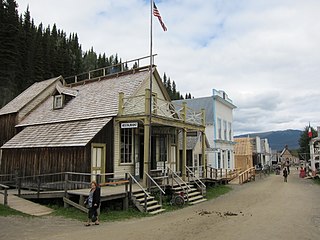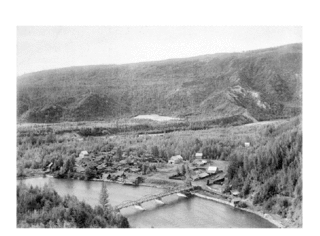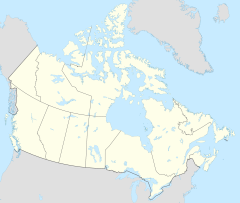
A tong is a type of organization found among Chinese immigrants predominantly living in the United States, with smaller numbers in Canada, Australia, and the United Kingdom. In Chinese, the word tong means "hall" or "gathering place". These organizations are described as secret societies or sworn brotherhoods and are often tied to criminal activity. In the 1990s, in most American Chinatowns, clearly marked tong halls could easily be found, many of which have had affiliations with Chinese organized crime.

Barkerville was the main town of the Cariboo Gold Rush in British Columbia, Canada, and is preserved as a historic town. It is located on the north slope of the Cariboo Plateau near the Cariboo Mountains 80 kilometres (50 mi) east of Quesnel. BC Highway 26, which follows the route of the Cariboo Wagon Road, the original access to Barkerville, goes through it.

Tam Kung or Tam Tai Sin (譚大仙) is a sea deity worshiped in Hong Kong and Macau.

Ping Shan Heritage Trail is a heritage trail located in the Ping Shan area of Yuen Long District, in Hong Kong. The trail was inaugurated on 12 December 1993 and was the first of its kind in Hong Kong. It passes through the villages of Hang Tau Tsuen, Hang Mei Tsuen and Sheung Cheung Wai and it includes several declared monuments and graded buildings.

The Bytown Museum is a museum in Ottawa located in the Colonel By Valley at the Ottawa Locks of the Rideau Canal at the Ottawa River, just below Parliament Hill. Housed in the Commissariat Building, Ottawa's oldest remaining stone building, the museum provides a comprehensive overview of the origins of Bytown and its development and growth into the present city of Ottawa.

The Dr Sun Yat-sen Museum is a museum in Central, Hong Kong. It is located in Kom Tong Hall, at 7 Castle Road, Central. After the preparation work undertaken by the Hong Kong Museum of History, the museum was opened on 12 December 2006, so as to commemorate the 140th birthday of the influential Chinese statesman.

Chinatown is an neighbourhood in Winnipeg, Manitoba, that was formed in 1909 and serves as an enclave of Chinese expatriates.

Multifamily residential is a classification of housing where multiple separate housing units for residential inhabitants are contained within one building or several buildings within one complex. Units can be next to each other, or stacked on top of each other. A common form is an apartment building. Many intentional communities incorporate multifamily residences, such as in cohousing projects. Sometimes units in a multifamily residential building are condominiums, where typically the units are owned individually rather than leased from a single apartment building owner.

Quesnel Forks, historically Quesnelle Forks, also simply known as "The Forks" or grandly known as "Quesnel City" is a ghost town in the Cariboo region of British Columbia, Canada. It is located the junction of the Quesnel and Cariboo Rivers and is 60 km southeast of Quesnel and only 11 km northwest of Likely.

The Wo Hing Society Hall is a building located at 858 Front Street in the Lahaina Historic District in Lahaina, Hawaii. Built around 1912, it served the growing Chinese population centered in Lahaina, primarily those working in the sugarcane industry as a social and fraternal hall for the Wo Hing Society. By the 1940s the declining Chinese population in Lahaina slowly made the building redundant and the property was neglected.
At their peak, there were six Chinese Society Halls on Maui. Operated by the Gee Kung Tong Society, these halls were created to provide services to immigrant Chinese workers, mostly working for the sugarcane plantations. All provided religious and political help, in addition to mutual aid. Only the Wo Hing Society Hall in Lahaina and the Ket Hing Society Hall in Kula have survived. Both were placed on the Hawaii State Register of Historic Places on July 30, 1982, and placed on the National Register of Historic Places on November 15, 1982. The Chee Kung Tong Society Hall was placed onto both State and Federal registers, but collapsed in 1996.

The Chee Kung Tong Society Hall was a former Chinese society hall located on 2151 Vineyard Street in Wailuku, Maui. Built to provide services to single immigrant Chinese males, mostly working for the sugarcane plantations, it provided religious and political help, in addition to mutual aid. Converted to a dormitory in the 1920s, it suffered neglect until finally collapsing in 1996. The site now contains remnants of the foundation, assorted cement structures, and a distinct lintel gate and wall facing the street. The site was placed on the Hawaii State Register of Historic Places and the National Register of Historic Places, but delisted from the State register after its collapse; it is still listed in the NRHP database.

The Isleton Chinese and Japanese Commercial Districts is located in Isleton, California in the Sacramento–San Joaquin River Delta, a large agricultural area in Sacramento County, California. Also known as the Isleton Asian American District, it served as the commercial and social center for both the town's Chinese and Japanese residents and the laborers working in nearby canneries, farms, and ranches. Isleton Asian American District is the only Asian community built in the Delta during the 1920s, and the architectural style of the buildings in the districts, particularly the use of pressed tin siding, is unique to other Delta Asian communities and to the town of Isleton.
The Tong Wars were a series of violent disputes beginning in the late 19th century among rival Chinese Tong factions centered in the Chinatowns of various American cities, in particular San Francisco. Tong wars could be triggered by a variety of inter-gang grievances, from the public besmirching of another Tong's honor, to failure to make full payment for a "slave girl", to the murder of a rival Tong member. Each Tong had salaried soldiers, known as boo how doy, who fought in Chinatown alleys and streets over the control of opium, prostitution, gambling, and territory.

Calgary City Hall, is the seat of government for Calgary City Council, located in the city's downtown core of Calgary, Alberta, Canada. The historic building completed in 1911 serves as the offices for Calgary City Council, consisting of the office of the Mayor, fourteen Councillors and municipal Clerk. Calgary City Hall originally housed the municipal council and portions of administration from its completion in 1911 until the construction of the Calgary Municipal Building adjacent to Old City Hall in 1985, which currently houses the offices of 2,000 civic administrators.

O'Reilly House is located in Placentia, Newfoundland and Labrador, Canada. It was built for Magistrate William O'Reilly who served as Magistrate of Placentia from 1897-1923. He was the son of Thomas O'Reilly who had been the magistrate of Placentia from 1877-97. In 1902, Magistrate O’Reilly employed the architect W.J. Ellis to build a Balustrade Queen Anne Victorian house that would serve as his family home.
The New Republic or New Republic Chinese Daily was a Chinese language newspaper published first in Victoria and then in Vancouver, Canada possibly from 1912 to 1984. Most early issues of the newspaper were lost or were sporadically preserved in BC Archives, Nanjing Library in China, and Library & Archives Canada (1957-1970).

The historic Chinatown in downtown Boise, Idaho existed around the 1870s to 1960s. The area was located along Idaho Street, and east from 8th Street along Front Street and Grove Street. Over the years, Boise's Chinatown consisted of multiple Chinese owned residencies and businesses including restaurants, merchandise stores, laundries, two herbal medicine shops operated by three generations of the Ah-Fong family, a Chinese Masonic Hall, and a Hip Sing Tong and Hop Sing Tong.
The Chee Kung Tong, or Gee Kung Tong, was a Chinese secret society established in 1880 and holds an active presence still. In earlier years, the society has also been recognized as the "Chinese Masons" and has been identified under various names such as Hongmen, Hongshuntang, and Yixingtang. The fraternity founded its headquarters in San Francisco in the United States.

















